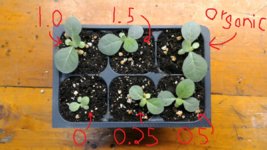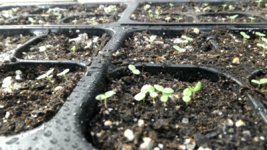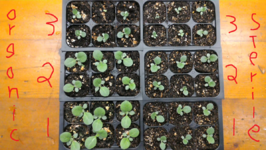Since many wonder if there over fertilizing or under fertilizing, or how bad urea is on seedlings. or maybe they cant trust their results cause they arent sure if the problem is low light ect.
im testing various strengths with common miracle grow tomato food
conditions are.
400 PPFD of light during the day, which is plenty for any size seedling.
fans for air flow 24/7
about 70-75f day temp, maybe 10 degrees lower some nights
soil is Pro Mix BX mycorrizae. which is peat, perlite, vermiculite, and tiny bit of dolomite lime for PH adjustiing the peat. so its basically nutritionless apart from some calcium and magnesium from lime.
Fertilizer. miracle grow tomato food, which contains urea. default strength of 1 means 1TBSP per gallon
Plant 1: water only control
Plant 2: 0.25 Strength
plant 3: 0.5 Strength
plant 4: 1 Strength
plant 5: 1.5 Strength
Plant 6: organic control
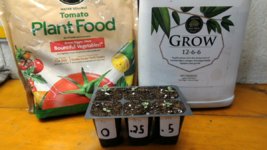
the organic control is, soil half Pro Mix, half well aged compost of various plants and manures live bugs and all, and some perlite to make up for compost diluting the ProMix's perlite
fertilizer for that is Grow 12-6-6 at Half recommended full strength, thats made of fish, feathers and seaweed
Test potential problems:
you may have noticed they arent the same tobaccos, since this wasnt planned i just had them from germination testing and didnt want to kill them, and my light was running anyway so i figured id do a test with them. i dont think this will matter much, the shorter and faster types i had weren't included. but im sure fertility varying by that much will give plenty of variation to notice.
also they were separated and transplanted into here from other containers. i worked very slow and careful not to damage roots and transplant well but that may have some effect compared to if this was thier original planting from seed. also they were growing in "Plant 6 conditions" prior to this. so this isnt a test as if they never had any nutrients so far. its just testing a healthy seedling root transplant from this point onward.
they were seeded on 3/20 and today 4/4 is day 1 of test and they were given their different fertilizers until it started to drip from bottom, since obviously bottom watering isnt an option here
ill post whenever something is noticeable
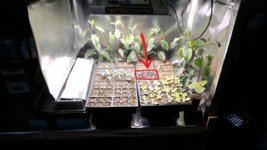
also feel free to place bets on which will do well or poorly lol
im testing various strengths with common miracle grow tomato food
conditions are.
400 PPFD of light during the day, which is plenty for any size seedling.
fans for air flow 24/7
about 70-75f day temp, maybe 10 degrees lower some nights
soil is Pro Mix BX mycorrizae. which is peat, perlite, vermiculite, and tiny bit of dolomite lime for PH adjustiing the peat. so its basically nutritionless apart from some calcium and magnesium from lime.
Fertilizer. miracle grow tomato food, which contains urea. default strength of 1 means 1TBSP per gallon
Plant 1: water only control
Plant 2: 0.25 Strength
plant 3: 0.5 Strength
plant 4: 1 Strength
plant 5: 1.5 Strength
Plant 6: organic control

the organic control is, soil half Pro Mix, half well aged compost of various plants and manures live bugs and all, and some perlite to make up for compost diluting the ProMix's perlite
fertilizer for that is Grow 12-6-6 at Half recommended full strength, thats made of fish, feathers and seaweed
Test potential problems:
you may have noticed they arent the same tobaccos, since this wasnt planned i just had them from germination testing and didnt want to kill them, and my light was running anyway so i figured id do a test with them. i dont think this will matter much, the shorter and faster types i had weren't included. but im sure fertility varying by that much will give plenty of variation to notice.
also they were separated and transplanted into here from other containers. i worked very slow and careful not to damage roots and transplant well but that may have some effect compared to if this was thier original planting from seed. also they were growing in "Plant 6 conditions" prior to this. so this isnt a test as if they never had any nutrients so far. its just testing a healthy seedling root transplant from this point onward.
they were seeded on 3/20 and today 4/4 is day 1 of test and they were given their different fertilizers until it started to drip from bottom, since obviously bottom watering isnt an option here
ill post whenever something is noticeable

also feel free to place bets on which will do well or poorly lol
Last edited:


